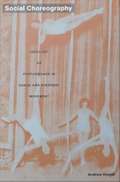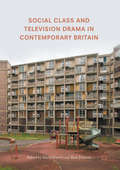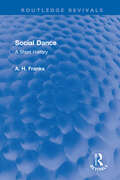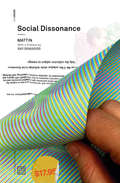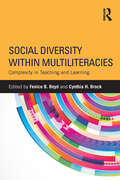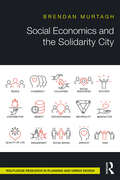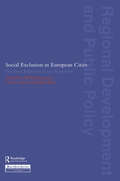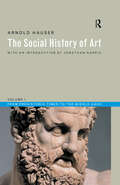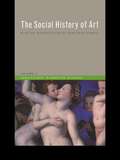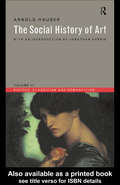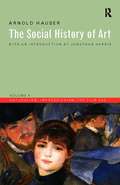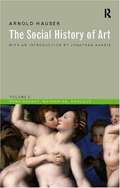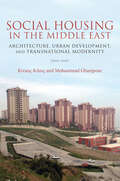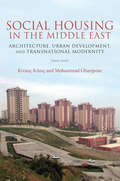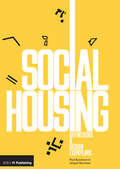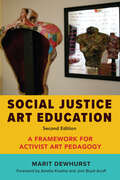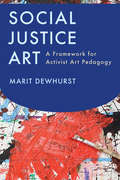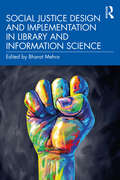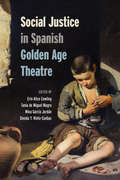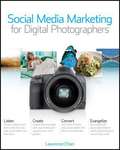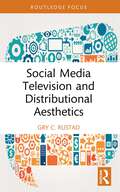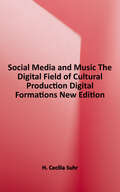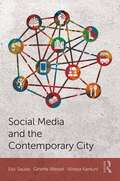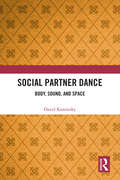- Table View
- List View
Social Choreography: Ideology as Performance in Dance and Everyday Movement
by Andrew HewittThrough the concept of "social choreography" Andrew Hewitt demonstrates how choreography has served not only as metaphor for modernity but also as a structuring blueprint for thinking about and shaping modern social organization. Bringing dance history and critical theory together, he shows that ideology needs to be understood as something embodied and practiced, not just as an abstract form of consciousness. Linking dance and the aesthetics of everyday movement--such as walking, stumbling, and laughter--to historical ideals of social order, he provides a powerful exposition of Marxist debates about the relation of ideology and aesthetics. Hewitt focuses on the period between the mid-nineteenth century and the early twentieth and considers dancers and social theorists in Germany, Britain, France, and the United States. Analyzing the arguments of writers including Friedrich Schiller, Theodor Adorno, Hans Brandenburg, Ernst Bloch, and Siegfried Kracauer, he reveals in their thinking about the movement of bodies a shift from an understanding of play as the condition of human freedom to one prioritizing labor as either the realization or alienation of embodied human potential. Whether considering understandings of the Charleston, Isadora Duncan, Nijinsky, or the famous British chorus line the Tiller Girls, Hewitt foregrounds gender as he uses dance and everyday movement to rethink the relationship of aesthetics and social order.
Social Class and Television Drama in Contemporary Britain
by Beth Johnson David ForrestThis collection is a wide-ranging exploration of contemporary British television drama and its representations of social class. Through early studio-set plays, soap operas and period drama, the volume demonstrates how class provides a bridge across multiple genres and traditions of television drama. The authors trace this thematic emphasis into the present day, offering fascinating new insights into the national conversation around class and identity in Britain today. The chapters engage with a range of topics including authorial explorations of Stephen Poliakoff and Jimmy McGovern, case studies of television performers Maxine Peake and Jimmy Nail, and discussions of the sitcom genre and animation form. This book offers new perspectives on popular British television shows such as Goodnight Sweetheart and Footballers' Wives, and analysis of more recent series such as Peaky Blinders and This is England.
Social Dance: A Short History (Routledge Revivals)
by Arthur FranksOriginally published in 1963 and authored by the then Editor of the Dancing Times, this was a pioneer work discussing not only the origins and development of many social dance forms from early times, but also relating these forms to their environment. As well as its role in social history, the book analyses the role of dance as a prime creative power in Renaissance spectacles which depicted and celebrated diplomatic, military and regal occasions. After a wide-ranging introductory chapter on the origins of dancing, the book takes the reader through the centuries, discussing in turn the Basse Danse and the Moresco of the Middle Ages, the Pavane, Galliard and Courante of the 16th Century, the Minuet of the 17th & 18th, the Allemande, the Waltz and the Polka as well as Jazz, the Cha Cha Cha, the Jive and Twist.
Social Dissonance (Urbanomic / Mono #10)
by MattinAn argument that by amplifying alienation in performance, we can shift the emphasis from the sonic to the social.Work in sound studies continues to seek out sound "itself"--but, today, when the aesthetic can claim no autonomy and the agency of both artist and audience is socially constituted, why not explore the social mediation already present within our experience of the sonorous? In this work, artist, musician, performer, and theorist Mattin sets out an understanding of alienation as a constitutive part of subjectivity and as an enabling condition for exploring social dissonance--the discrepancy between our individual narcissism and our social capacity. Mattin's theoretical investigation is intertwined with documentation of a concrete experiment in the form of an instructional score (performed at documenta 14, 2017, in Athens and Kassel) which explores these conceptual connotations in practice, as players use members of the audience as instruments, who then hear themselves and reflect on their own conception and self-presentation. Social Dissonance claims that, by amplifying alienation in performance and participation in order to understand how we are constructed through various forms of mediation, we can shift the emphasis from the sonic to the social, and in doing so, discover for ourselves that social dissonance is the territory within which we already find ourselves, the condition we inhabit.
Social Diversity within Multiliteracies: Complexity in Teaching and Learning
by Fenice B. Boyd and Cynthia H. BrockUsing a multiliteracies theoretical framework highlighting social diversity and multimodality as central in the process of meaning making, this book examines literacy teaching and learning as embedded in cultural, linguistic, racial, sexual, and gendered contexts and explores ways to foster learning and achievement for diverse students in various settings. Attending simultaneously to topics around two overarching and interrelated themes—languages and language variations, and cultures, ethnicities, and identities—the chapter authors examine the roles that multiliteracies play in students’ lives in and out of classrooms. In Part I, readers are asked to examine beliefs and dispositions as related to different languages, language varieties, cultures, ethnicities, and identities. Part II engages readers in examining classroom and community practices related to different languages and language varieties, cultures, ethnicities, and identities.
Social Economics and the Solidarity City
by Brendan MurtaghSocial Economics and the Solidarity City explores the impact and potential of the social economy as a site of urban struggle, political mobilization and community organization. The search for alternatives to the neoliberal logic governing contemporary cities has often focused on broad and ill-defined political, social and environmental movements. These alternatives sometimes fail to connect with the lived realities of the city or to change the lives of those exploited in neoliberal restructuring. This book seeks to understand the capacity of the social economy to revitalize urban ethics, local practices and tangible political alterity. Providing a critical account of the social economy and its place in urban and state restructuring, this book draws on a range of international cases to argue that the social economy can be made a transformative space. Evaluating community enterprises, social finance, and solidarity economics, author Brendan Murtagh maps the possibilities, contradictions and tactics of moving the rhetoric of the just city into local and global action.
Social Exclusion in European Cities: Processes, Experiences and Responses (Regions and Cities #No.23)
by Ali Madanipour Göran Cars Judith AlienAcross Europe concern is rising over the disintegration of social relations and the growing number of people who are being socially excluded. social Exclustoin in European Cities, the first major study of this topic, provides a definition of social exclusion and looks at both the processes which cause it and the dimensions of the problem throughout Europe. The experiences of people living in areas or neighbourhoods with low rates of social integration are considered, illuminating the human impact of exclusion where it is most visible. Finally the contributors evaluate the various policy and community initiatives which are currently confronting the problem in a wide sample of European Cities on a variety of levels, from inform individual actions to supra-national European Union policy, and suggest new ways in which social exclusion could be tackled. With most large cities experiencing some degree of social exclusion, this is an important volume for all those working in the areas of regional policy, town planning, housing management, social work, community development, sociology, political science and urban studies.
Social History of Art, Volume 1: From Prehistoric Times to the Middle Ages
by Arnold HauserFirst published in 1951 Arnold Hausers commanding work presents an account of the development and meaning of art from its origins in the Stone Age through to the Film Age. Exploring the interaction between art and society, Hauser effectively details social and historical movements and sketches the frameworks in which visual art is produced.This new edition provides an excellent introduction to the work of Arnold Hauser. In his general introduction to The Social History of Art, Jonathan Harris asseses the importance of the work for contemporary art history and visual culture. In addition, an introduction to each volume provides a synopsis of Hausers narrative and serves as a critical guide to the text, identifying major themes, trends and arguments.
Social History of Art, Volume 2: Renaissance, Mannerism, Baroque
by Arnold HauserFirst published in 1951 Arnold Hauser's commanding work presents an account of the development and meaning of art from its origins in the Stone Age through to the Film Age. Exploring the interaction between art and society, Hauser effectively details social and historical movements and sketches the frameworks in which visual art is produced.This new edition provides an excellent introduction to the work of Arnold Hauser. In his general introduction to The Social History of Art, Jonathan Harris asseses the importance of the work for contemporary art history and visual culture. In addition, an introduction to each volume provides a synopsis of Hauser's narrative and serves as a critical guide to the text, identifying major themes, trends and arguments.
Social History of Art, Volume 3: Rococo, Classicism and Romanticism
by Arnold HauserFirst published in 1951 Arnold Hausers commanding work presents an account of the development and meaning of art from its origins in the Stone Age through to the Film Age. Exploring the interaction between art and society, Hauser effectively details social and historical movements and sketches the frameworks in which visual art is produced.This new edition provides an excellent introduction to the work of Arnold Hauser. In his general introduction to The Social History of Art, Jonathan Harris asseses the importance of the work for contemporary art history and visual culture. In addition, an introduction to each volume provides a synopsis of Hausers narrative and serves as a critical guide to the text, identifying major themes, trends and arguments.
Social History of Art, Volume 4: Naturalism, Impressionism, The Film Age
by Arnold HauserFirst published in 1951 Arnold Hausers commanding work presents an account of the development and meaning of art from its origins in the Stone Age through to the Film Age. Exploring the interaction between art and society, Hauser effectively details social and historical movements and sketches the frameworks in which visual art is produced.This new edition provides an excellent introduction to the work of Arnold Hauser. In his general introduction to The Social History of Art, Jonathan Harris asseses the importance of the work for contemporary art history and visual culture. In addition, an introduction to each volume provides a synopsis of Hausers narrative and serves as a critical guide to the text, identifying major themes, trends and arguments.
Social History of Art, Volume II: Renaissance, Mannerism, Baroque (Third Edition)
by Jonathan Harris Arnold HauserFirst published in 1951 Arnold Hauser's commanding work presents an account of the development and meaning of art from its origins in the Stone Age through to the Film Age. Exploring the interaction between art and society, Hauser effectively details social and historical movements and sketches the frameworks in which visual art is produced. This new edition provides an excellent introduction to the work of Arnold Hauser. In his general introduction to The Social History of Art, Jonathan Harris asseses the importance of the work for contemporary art history and visual culture. In addition, an introduction to each volume provides a synopsis of Hauser's narrative and serves as a critical guide to the text, identifying major themes, trends and arguments.
Social Housing in the Middle East: Architecture, Urban Development, and Transnational Modernity
by Mohammad Gharipour Kivanç KilinçEssays on architecture in Kuwait, Iran, Israel, and other nations in the region, and how it can and must address the needs of local residents. As oil-rich countries in the Middle East are increasingly associated with soaring skyscrapers and modern architecture, attention is being diverted away from the pervasive struggles of social housing in those same urban settings. Social Housing in the Middle East traces the history of social housing—both gleaming postmodern projects and bare-bones urban housing structures—in an effort to provide a wider understanding of marginalized spaces and their impact on identities, communities, and class. While architects may have envisioned utopian or futuristic experiments, these buildings were often constructed with the knowledge and skill sets of local workers, and the housing was in turn adapted to suit the modern needs of residents. This tension between local needs and national aspirations are linked to issues of global importance, including security, migration, and refugee resettlement. The essays collected here consider how culture, faith, and politics influenced the solutions offered by social housing; they provide an insightful look at how social housing has evolved since the nineteenth century and how it will need to adapt to suit the twenty-first.&“Essential reading . . . for architectural and social historians, planners, and policy makers.&” —CAA Reviews
Social Housing in the Middle East: Architecture, Urban Development, and Transnational Modernity
by Mohammad Gharipour Kıvanç KılınçAs oil-rich countries in the Middle East are increasingly associated with soaring skyscrapers and modern architecture, attention is being diverted away from the pervasive struggles of social housing in those same urban settings. Social Housing in the Middle East traces the history of social housing—both gleaming postmodern projects and bare-bones urban housing structures—in an effort to provide a wider understanding of marginalized spaces and their impact on identities, communities, and class. While architects may have envisioned utopian or futuristic experiments, these buildings were often constructed with the knowledge and skill sets of local workers, and the housing was in turn adapted to suit the modern needs of residents. This tension between local needs and national aspirations are linked to issues of global importance, including security, migration, and refugee resettlement. The essays collected here consider how culture, faith, and politics influenced the solutions offered by social housing; they provide an insightful look at how social housing has evolved since the 19th century and how it will need to adapt to suit the 21st.
Social Housing: Definitions and Design Exemplars
by Paul Karakusevic Abigail BatchelorThis is a growing sector undergoing a huge period of change - with local authorities able to build their own housing for the first time in decades. Social Housing: Definitions and Design Exemplars explores how social/affordable housing has been delivered and designed with success throughout the UK in the last 10 years. Weaving together exemplar case studies, essays and interviews with social housing pioneers and clients, this book demonstrates real-life best practice responses to the challenges associated with housing provision, with a focus on design ideas.
Social Justice Art Education, Second Edition: A Framework for Activist Art Pedagogy (Routledge Research In Arts Education Ser.)
by Marit DewhurstExpanding on a groundbreaking framework, this revised edition connects activist art education with current campaigns for social justice. Nearly a decade after Social Justice Art, innovative arts educator Marit Dewhurst returns with a new edition offering further guidance for developing meaningful, justice-centered art programming. Reflecting on a growing interest in the field and its place within larger movements that uses creative strategies to drive social change, Dewhurst brings new research to bear on her interviews with educators, artists, and students to suggest clear, actionable approaches to facilitating the collaborative process of creating art for social change. In Social Justice Art Education, Dewhurst examines how to teach art-making to address systems of injustice, how to talk about the process, and the role of activist art projects not only in school classrooms but also within museum education, afterschool education, and other youth programming. In a new chapter, she introduces essential steps that prepare educators to engage in this work: recognizing power differentials, identifying community strengths, and nurturing relationships. Through real-world examples, Dewhurst highlights three key learning processes—connecting, questioning, and transforming—and frames a critical arts pedagogy that incorporates collaboration, inquiry-based discussion, and changemaking into arts curricula. This invigorating work provides common language and concrete support for educators and others who want to expand and refine their practices, empowering students through liberatory education that aims to inspire social change.
Social Justice Art: A Framework for Activist Art Pedagogy
by Marit DewhurstIn this lively and groundbreaking book, arts educator Marit Dewhurst examines why art is an effective way to engage students in thinking about the role they might play in addressing social injustice. Based on interviews and observations of sixteen high schoolers participating in an activist arts class at a New York City museum, Dewhurst identifies three learning processes common to the act of creating art that have an impact on social justice: connecting, questioning, and translating. Noting that &“one of the challenges of social justice art education has been the difficulty of naming effective strategies that can be used across multiple contexts,&” Dewhurst outlines core strategies for an &“activist arts pedagogy&” and offers concrete suggestions for educators seeking to incorporate activist art projects inside or outside formal school settings.Social Justice Art seeks to give common language to educators and others who are looking to expand and refine their practices in an emerging field, whether they work in art education, social justice programming, or youth development.
Social Justice Design and Implementation in Library and Information Science
by Bharat MehraSocial Justice Design and Implementation in Library and Information Science presents a range of case studies that have successfully implemented social justice as a designed strategy to generate community-wide changes and social impact. Each chapter in the collection presents innovative practices that are strategized as intentional, deliberate, systematic, outcome-based, and impact-driven. They demonstrate effective examples of social justice design and implementation in LIS to generate meaningful outcomes across local, regional, national, and international settings. Including reflections on challenges and opportunities in academic, public, school, and special libraries, museums, archives, and other information-related settings, the contributions present forward-looking strategies that transcend historical and outdated notions of neutral stance and passive bystanders. Showcasing the intersections of LIS concepts and interdisciplinary theories with traditional and non-traditional methods of research and practice, the volume demonstrates how to further the social justice principles of fairness, justice, equity/equality, and empowerment of all people, including those on the margins of society. Social Justice Design and Implementation in Library and Information Science will be of great interest to LIS educators, scholars, students, information professionals, library practitioners, and all those interested in integrating social justice and inclusion advocacy into their information-related efforts to develop impact-driven, externally focused, and community-relevant outcomes.
Social Justice in Spanish Golden Age Theatre (Toronto Iberic)
by Erin Alice Cowling Tania De Miguel Magro Mina García Jordán Glenda Y. Nieto-CuebasThis collection of original new essays focuses on the many ways in which early modern Spanish plays engaged their audiences in a dialogue about abuse, injustice, and inequality. Far from the traditional monolithic view of theatrical works as tools for expanding ideology, these essays each recognize the power of theatre in reflecting on issues related to social justice. The first section of the book focuses on textual analysis, taking into account legal, feminist, and collective bargaining theory. The second section explores issues surrounding theatricality, performativity, and intellectual property laws through an analysis of contemporary adaptations. The final section reflects on social justice from the practitioners’ point of view, including actors and directors. Social Justice in Spanish Golden Age Theatre reveals how adaptations of classical theatre portray social justice and how throughout history the writing and staging of comedias has been at the service of a wide range of political agendas.
Social Media Marketing for Digital Photographers
by Lawrence ChanTeaching photographers how to use social media to grow their businessesWith the rapid rise of both digital photography and social media, amateur photographers can now turn what was once a hobby into a thriving business. Social media sites such as Twitter, Facebook, LinkedIn, and Flickr offer loads of exciting marketing opportunities. This practical guide from a well-respected professional photographer shows you how to take advantage of social media to grow a profitable photography business. If you've been wondering which social media sites to use, how to use them, how often to use them, and more, this book is for you.Guides you through how to market your photography business on Twitter, Facebook, LinkedIn, Flickr, and other social media sitesShows you how to translate your use of social media into increased profits Helps you answer such questions as "Which sites should I use?" and "How do I get started?"Provides invaluable testimonials from top photographers discussing their social media business success storiesGuides you through inspiring brand evangelists through social mediaTeaches important survival tips for your social media programIn addition to the powerful strategies, interviews were conducted with thought leaders in the photo industry -- Kenny Kim, Zach and Jody Gray, Jerry Ghionis, Becker, Jasmine Star, Catherine Hall, and Grace Ormonde -- to provide you with all-star tips and tricks. Whether you're just starting a professional photography business or are a seasoned pro looking for good advice on using social media to promote yourself, Social Media Marketing for Digital Photographers is the book you need.
Social Media Television and Distributional Aesthetics (Routledge Focus on Television Studies)
by Gry C. RustadSocial Media Television and Distributional Aesthetics explores this distinct fictional form that merges the genres, structures and affordances of television with those of social media and what it entails for contemporary television and media culture and for our experience of new and old media in everyday life.Centred around five key case studies – Skam, Lik meg, Dead Girls Detective Agency, Content and Eva.Stories – this book offers insight into how different social media platforms facilitate distinct aesthetics and content; transnational aspects of social media television; and how different production cultures and industries operate in its production. This analysis extrapolated out into broader principles and theoretical arguments that will help scholars working on a wide variety of questions of television and social media, digitalization, technology, convergence, media aesthetics, production cultures, audience cultures and globalization in the future. Developing new theoretical perspectives to understand what social media television is and can be and creating new methodological frameworks to analyze television and new media as an aesthetic experience, the author proposes distributional aesthetic as the main analytical framework arguing that distribution can be understood as an aesthetic form defined as a situated aesthetic experience in time and space.This book will be relevant for scholars, instructors, students and practitioners working within television studies, social media studies, media aesthetics, and visual and digital culture.
Social Media and Music: The Digital Field of Cultural Production
by H. Cecilia SuhrThis book explores social networking sites as the digital field of cultural production by loosely drawing from Pierre Bourdieu’s notion of field and capital. The book examines four case studies on MySpace, YouTube, Second Life, and Indaba Music, and the roles and the impact they have on the music industry and musicians. In doing so, the author explores the groundbreaking developments that empower independent musicians and problematizes the emergence of a variety of issues symptomatic of social media environments at the height of convergence culture.
Social Media and the Contemporary City
by Eric Sauda Ginette Wessel Alireza KarduniThe widespread adoption of smartphones has led to an explosion of mobile social media data, more than a billion messages per day that continuously track location, content, and time. Social Media in the Contemporary City focuses on the effects of social media on local communities and urban space in a variety of political and economic settings related to social activism, informal economic activity, public art, and global extremism. The book covers events ranging from Banksy art installations, mobile food trucks, and underground restaurants, to a Black Lives Matter protest, the Christchurch mosque shootings, and the Pulse nightclub shooting. The interplay between urban space, local community, and social media in each case study requires diverse methodologies that are both computational (i.e. machine learning, social network analysis, and natural language processing) and ethnographic (i.e. semi-structured interviews, thematic analysis, and site analysis). The book views social media not as a replacement for the local community or urban space but rather as a translation of the uses and meanings of all three realms. The book will be of interest to students, researchers, and instructors in a number of disciplines including urban design/planning, media studies, geography, and communications.
Social Partner Dance: Body, Sound, and Space
by David KaminskySocial Partner Dance: Body, Sound, and Space is an ethnographic theory of social partner dancing built on participant observation and interviews with instructors of tango, lindy hop, salsa, blues, and various other forms. The work establishes a general analytical language for the study of these dances, based on the premise that a thorough understanding of any lead/follow form must consider in depth how it manages the four-part relationship between self, partner, music, and surroundings. Each chapter begins with a brief vignette on a distinct dance form and explores the focused worlds of partnered dancing done for the joy and entertainment of the dancers themselves. Grounded intellectually in embodiment studies and sensory ethnography, and empirically in ethnographic fieldwork, Social Partner Dance promotes scholarship that understands the social, cultural, and political functions of partner dance through its embodied practice.
Social Photography: Make All Your Smartphone Photos One In A Billion
by Daniela BowkerHot photo apps come and go, but the practice of shooting and sharing is universal and is now a fundamental part of the way that we communicate with each other. Photos aren’t printed on paper anymore – they are shown on screens, and everywhere they are shown the viewer is invited to like or share. <P><P> Social Photography will show you how to create photos that will be clicked on, liked, shared, and maybe even go viral. A must for anyone who takes their online profile seriously, it will show you how to give your photos a fresh look, it will give you hundreds of posing and shooting ideas, and it will let you share your life’s most exciting moments wider than ever before.
